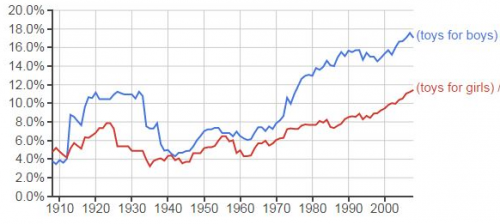Some nice news has come out lately that the occasional toy store is taking the words boy and girl off of their aisle signs — mostly in Sweden, I say half-jokingly — but Google ngrams suggests that we’re nowhere near backing off of separating children’s toys by sex.
Sociologist Philip Cohen graphed the frequency of “toys for boys” and “toys for girls” relative to “toys for children.” This is just language, and it’s just American English, but it’s one indication that the consciousness raising efforts of organizations like Let Toys Be Toys is still on the margins of mainstream society.

As you can see from the graph, the extent to which children are actively talked about as gendered subjects varies over time.
One explanation for why companies resist androgynous toys and clothes for children — an arguably adults, too — has to do with money. If parents with a boy and a girl could get away with one set of toys, they wouldn’t need to buy a second. And if they could hand down clothes from girls to boys and vice versa, they would buy less clothes. The same could be said for borrowing and trading between family members and friends.
It would really cut into the profits of these companies if we believed that all items for children were interchangeable. They work hard to sustain the lie that they are not.
Cross-posted at Pacific Standard.
Lisa Wade, PhD is an Associate Professor at Tulane University. She is the author of American Hookup, a book about college sexual culture; a textbook about gender; and a forthcoming introductory text: Terrible Magnificent Sociology. You can follow her on Twitter and Instagram.
Comments 18
Bill R — December 13, 2014
Companies would love to be able to increase revenue by pushing the notion of separate toys for girls and boys--and they may try--but in the end they need to address the needs of the market to survive. If boys and girls didn't want toys that differentiate them their parents wouldn't buy them--and if parents were turned off to the idea they might not buy them regardless of the desires of their children.
Don't look to the big bad corporations to explain this; look to society itself.
JenUnderscore_ — December 13, 2014
I don't know if Google searches is the best barometer due to auto fill. As you type "toys for..." it'll auto complete, and people (especially those on mobile) will click whatever is most convenient. The 'most searched' is self-perpetuating. Plus, who's going to search 'toys for... children' presumably all toys are for children. Try... 'toys for toddlers' or 'toys for 5 year olds' or something more specific.
Josh — December 13, 2014
I'm not sure the profit motive has much explanatory power here. Arguably, it has always been there so how do we explain changes over time? Are firms suddenly becoming more profit hungry?
guest — December 13, 2014
"toys for kids/toys for children" is also on the rise over this period (check ngrams). Also check "clothes for girls" or "clothes for boys" per Bill's comment below.
Japaniard — December 13, 2014
The problem with Google ngrams is that when you use them with more than two factors and attempt to normalize the results, you really can craft them to display any result you want.
By normalizing to "toys for kids" for example the new headline becomes Gender Segregation of Toys at an All Time Low After Peak in 80s Thanks to Concerted Efforts of Groups Like Let Toys Be Toys.
But of course, headlines that read "problem solved" are much less interesting than headlines that say "problem on the rise", so I can see why my graph wasn't chosen.
Chart of the Week: Gender Segregation of Toys Is On the Rise feedly | a boy's head — December 14, 2014
[…] Chart of the Week: Gender Segregation of Toys Is On the Rise // Sociological […]
Gendered Lego…then and now. | floweren — December 18, 2014
[…] 1. Gendered Lego article […]
GENDER SEGREGATION OF TOYS IS ON THE RISE | Welcome to the Doctor's Office — December 23, 2014
[…] by Lisa Wade from SocImages […]
Geschlechtsspezifische Schul-Aufgaben „neu und nur für Jungs“ | feministische studien — December 28, 2014
[…] Indem die Spielinteressen von Kindern auf diese Weise weiterhin polarisiert werden, wirken geschlechterspezifische Toys als Nötigungen und […]
GENDER MARKETING | brisegladecm201d — June 25, 2015
[…] post originally appeared on Sociological Images, a Pacific Standard partner site, as “Chart of the […]
Darpana Kapoor — December 2, 2017
Thanks for sharing such a valuable information.
Kids toys
عطر رجالي — November 16, 2021
Gendered Lego…then and now.
thank you
Qeshawn M Lockett — September 12, 2022
I think if their revenue would be cut then leave it how it is. Regardless of the it being the original way a parent is going to raise their child how they see fit. Some parents say leave it some say change it regardless it won't be fair in someone's eyes and we are either a girl or a boy so buy the toy you want.
Leslie J Vaughn — October 21, 2024
Companies are always going to try to bring in more money regardless of the situation of the gender of the child. Even with the age notification it still does not have a point, children will play with what they want to. It doesn't matter if the parent tries to make them play with what they think, as soon as you walk away, they will still find their way to the other toy if that is what caught their eye.